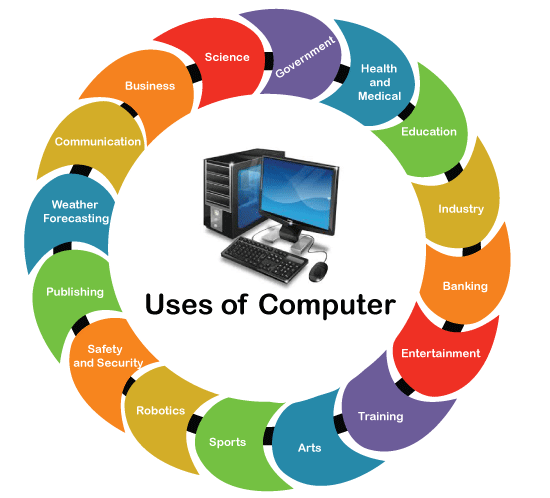Computers play a pivotal role in various aspects of modern life, influencing and transforming the way individuals, businesses, organizations, and societies operate, communicate, learn, work, and interact. Here are some of the primary uses and applications of computers:
1. Information Processing and Management:
Data Storage and Retrieval: Computers facilitate the storage, organization, management, and retrieval of vast amounts of data, information, files, documents, and digital content, enabling efficient data management, access, and utilization.
Information Analysis and Processing: Computers support data analysis, processing, computation, and modeling, enabling advanced calculations, simulations, predictions, and insights generation in various domains, disciplines, and applications.
2. Communication and Connectivity:
Internet and Networking: Computers enable internet connectivity, communication, and networking, facilitating online access, web browsing, email communication, social media interaction, and online collaboration, connecting individuals, communities, businesses, and global networks worldwide.
Digital Communication Tools: Computers support digital communication tools, platforms, and applications, such as instant messaging, video conferencing, VoIP calls, and virtual meetings, enabling real-time communication, collaboration, and interaction across distances and locations.
3. Education and Learning:
E-Learning and Digital Education: Computers support e-learning, online education, and digital learning platforms, providing access to educational resources, courses, materials, tutorials, and interactive content, facilitating remote learning, skill development, and lifelong learning opportunities for students, educators, and learners worldwide.
Educational Software and Tools: Computers enable the use of educational software, applications, simulations, and tools, fostering interactive, engaging, and personalized learning experiences, and supporting educational innovation, creativity, and excellence in teaching and learning environments.
4. Business and Enterprise:
Business Operations and Management: Computers support business operations, processes, management, and administration, facilitating business productivity, efficiency, automation, optimization, and innovation across various functions, departments, and sectors, and enabling business growth, competitiveness, and success in the digital economy.
Enterprise Systems and Solutions: Computers enable the deployment and integration of enterprise systems, solutions, and technologies, such as ERP (Enterprise Resource Planning), CRM (Customer Relationship Management), SCM (Supply Chain Management), and BI (Business Intelligence), supporting business transformation, integration, intelligence, and digital transformation initiatives in organizations and enterprises.
5. Entertainment and Media:
Digital Entertainment and Media: Computers support digital entertainment, media, content creation, production, distribution, and consumption, enabling the creation, editing, sharing, streaming, and enjoyment of multimedia content, music, videos, games, films, and digital experiences across various platforms, devices, and channels.
Gaming and Interactive Experiences: Computers facilitate gaming, interactive entertainment, virtual reality (VR), augmented reality (AR), and immersive experiences, enabling gamers, users, and audiences to engage, interact, and explore virtual worlds, simulations, and digital environments with realism, creativity, and interactivity.
6. Research and Innovation:
Scientific Research and Exploration: Computers support scientific research, exploration, experimentation, and discovery, enabling researchers, scientists, and scholars to conduct simulations, analysis, modeling, and computations, and to advance knowledge, innovation, and breakthroughs in science, technology, engineering, and mathematics (STEM) disciplines.
Technological Innovation and Development: Computers drive technological innovation, development, and advancement, fostering the creation, evolution, and integration of new technologies, solutions, applications, and services, and supporting innovation, creativity, and progress in the IT industry, sectors, and ecosystems worldwide.





Either way the teacher or student will get the solution to the problem within 24 hours.